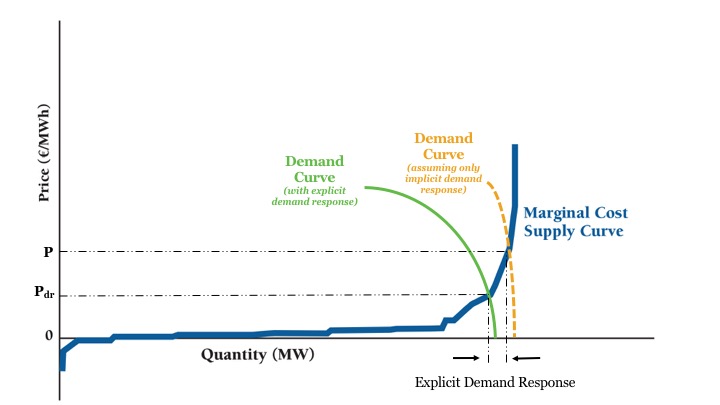Explicit demand response, where aggregators enable small commercial and domestic consumers to directly participate in the wholesale power market by flexing their demand, is a vital resource in the transition to a sustainable electricity system. However, barriers to the successful development of this vital resource exist in many Member States, including the need for aggregators to obtain permission from the customer’s supplier and to compensate the supplier for lost income.
As the potential for demand response is significant and the savings likely exceed associated costs by a considerable amount, we should be doing everything we can to tear down barriers and open markets to this customer-centric resource. Article 17 of the European Commission’s proposed Electricity Directive is a positive step in this direction and should be widely supported. It ends the requirement for an aggregator to obtain permission to operate on a consumer’s demand or to compensate the consumer’s supplier (other than in some imbalance-related “exceptional circumstances”).
Unfortunately, incumbent suppliers are pushing back on the Commission’s proposal, maintaining that energy they purchase up front is transferred to aggregators free of charge, who then profit by selling it on, leaving suppliers unable to bill customers for unused energy. In reality, this is not the case and obfuscates the tangible benefits that aggregated demand response delivers. More details on the following discussion are available in the accompanying policy brief, Unleashing Demand Response with Effective Supplier Compensation.
Aggregators Help Customers Reduce Demand, Avoid Expensive Generation Costs
The services provided by demand response aggregators simply allow an energy supplier’s customers to reduce their demand. When the aggregator offers this product to the wholesale energy market, it removes the need to generate an equivalent amount of energy. As no more energy can be generated than is consumed, the aggregator’s product reduces the amount of energy generated and, hence, market costs. No energy is transferred; it is simply not used.
Figure 1 shows that even modest reductions in demand can avoid the need to run high-marginal-cost generation or other more costly measures, reducing market clearing prices. This allows suppliers to make significant savings when buying energy for their customers, and one would expect that most of these savings will make their way to customers through competitive or, where necessary, regulatory pressure. The point to note here is that all customers benefit from cost-competitive demand response, not just those customers who reduce their demand. It is a genuine societal benefit in the form of lower wholesale and retail energy prices and avoidance of uneconomic investment.

Figure 1. Explicit Demand Response Reduces Wholesale Electricity Prices
As suppliers cannot bill customers for energy not consumed, they are demanding additional compensation from aggregators to recover the lost revenue associated with explicit downward demand response. In the case where customers simply reduce consumption in response to price signals delivered through a time-of-use or dynamic tariff (price-based or implicit demand response), there is no suggestion that those customers should compensate the supplier for loss of revenue. However, requiring aggregators to compensate suppliers for lost revenue essentially amounts to the same thing.
Similar Debate in the US
Order 745 of the Federal Energy Regulatory Commission (FERC) in the U.S. requires wholesale market operators to pay the same wholesale price to providers of demand response as is paid to generators—essentially the same situation as exists in European markets today. No discount or supplier compensation is applied. Order 745 contains a “net-benefit” test to ensure that a demand response provider only receives the full market value if there is an overall benefit to consumers. This is a precaution the Commission may want to consider if it believes the “no-compensation” position set out in Article 17 of the proposed directive could lead to excessive demand response deployment.
Simple, Straight-Forward Alternative to Supplier Compensation
Last fall, I suggested an alternative to the complex and unfair practice of requiring demand response aggregators to pay energy suppliers for unused energy. Under this approach, suppliers retain a small portion of the wholesale market savings, which should always exceed, and often dwarf, any income lost by suppliers due to customers opting not to consume.
Relying on the retention of some of these wholesale market savings to ensure that suppliers remain financially whole rather than via negotiated or administered compensation is both a pragmatic and just solution. The alternative of direct compensation proposed by suppliers will significantly hinder the development of implicit demand response, resulting in fewer benefits to be enjoyed in the first place. Furthermore, as the reduction in wholesale energy prices brought about by demand response should be enjoyed by all customers via lower retail tariffs, it seems appropriate that all customers should share in the associated costs and not just the providers of that demand response. The proposal also has the virtue of simplicity, with no negotiation between aggregators and suppliers and no need to make the difficult assumptions necessary in establishing an administered alternative to negotiation, with the attendant risks of over– or under–compensation.
Article 17 of Proposed Electricity Directive Removes Barriers to Demand Response
In its current form, Article 17 removes a significant barrier to the development of explicit demand response and the enhanced customer market participation and flexibility so necessary to a cost-effective transition to a low-carbon electricity system. Any modification of the current wording to require aggregators to compensate suppliers for income associated with energy not consumed, would undermine these aims.
Photo Credit: Consumers Energy
